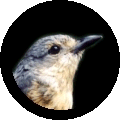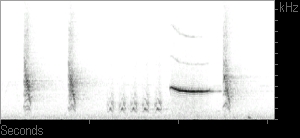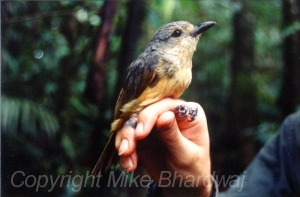 Bower's Shrike-thrush
Bower's Shrike-thrush
Colluricincla boweri
 Figure 1. Spectrogram of the
Bower's Shrike-thrush song.
Figure 1. Spectrogram of the
Bower's Shrike-thrush song. (The seventh song in the sound file is depicted.)

Bower's Shrike-thrush - Colluricincla boweri
The bower’s shrike-thrush has one of the most remarkable voices of the birds endemic to the Atherton area. Each male has a repertoire of songtypes that are composed of sweeping whistles, stuttered trills, and rhythmic notes that sound remarkably like someone smacking their lips. In the above sound file you can hear a male repeat the same song three times, then change to a different song type, repeat that song type three types, and then change again. In just a short period of recording, I detected fifteen song types in one population of shrike-thrushes. Although the largest number of song types I recorded form a single male was eight, I would guess that each male’s repertoire is much larger than this. Males sometimes vary their songs by adding and dropping syllables, and by quietly improvising combinations of other song types, as you can hear in the middle of the sound file.
Bower’s shrike-thrush songs cover an impressive frequency range, from 1000 to 5000 Hz, and they can be delivered at highly variable song rates, as quickly as one song every two seconds. Their songs are often interspersed with a distinctive call note, which to my ear sounds like ‘chow’ although Pizzey and Knight suggest ‘tuck’ (four call notes can be heard at the end of the sound file). Bower’s shrike-thrushes sing throughout the day. Their behaviour is quite obvious as they move between the middle understory and the upper canopy.
Anyone looking for a model system to investigate repertoire singing in an Australian bird should consider these unstudied animals. Their singing behaviour seems to follow a pattern similar to song sparrows, Melospiza melodia. However, bower’s shrike-thrushes appear to have much larger repertoires and an ability to mix-and-match songs.
Habitat.
Bower’s shrike-thrushes live in rainforest habitat that is also home to the tooth-billed bowerbird, the satin bowerbird, and the golden bowerbird, and it may be this feature for which the bower’s shrike-thrush is named.
Range.
This endemic bird is found only in the highlands of northeast Queensland.
Further Reading.
G. Pizzey & F. Knight. 1999.
Field
guide to the birds of Australia. Harper Collins, Sydney.
No recordings, photographs, or other information may be used without written permission (email me at dmennill AT uwindsor DOT ca).